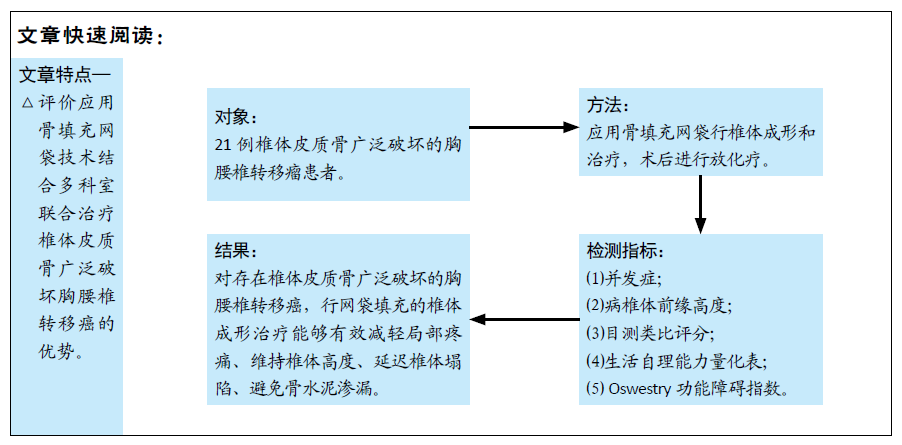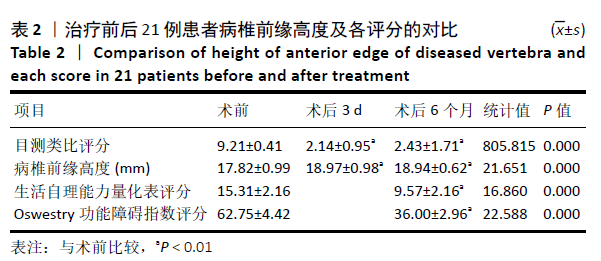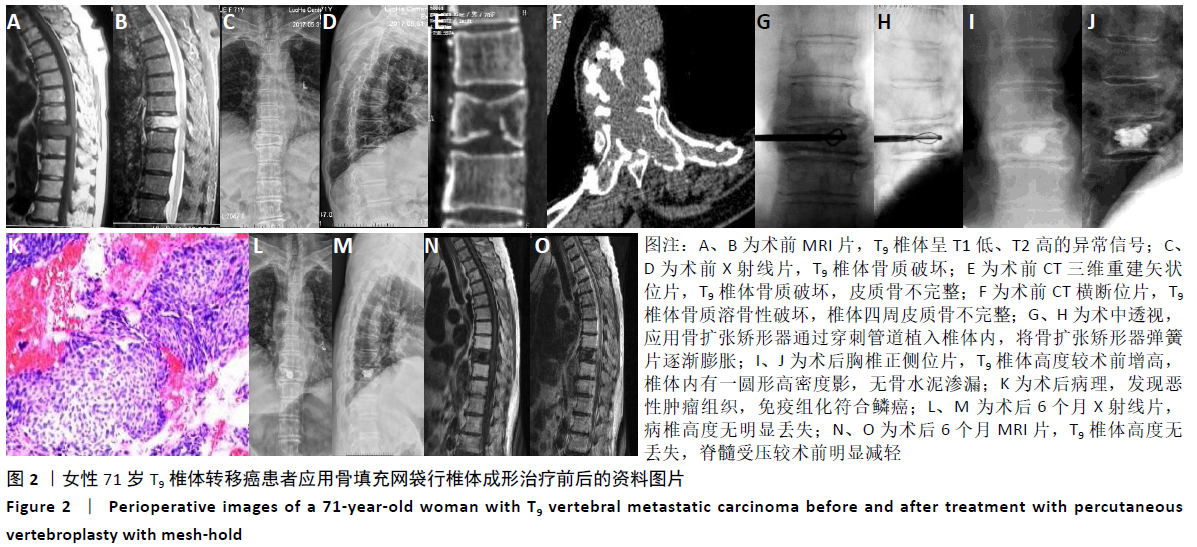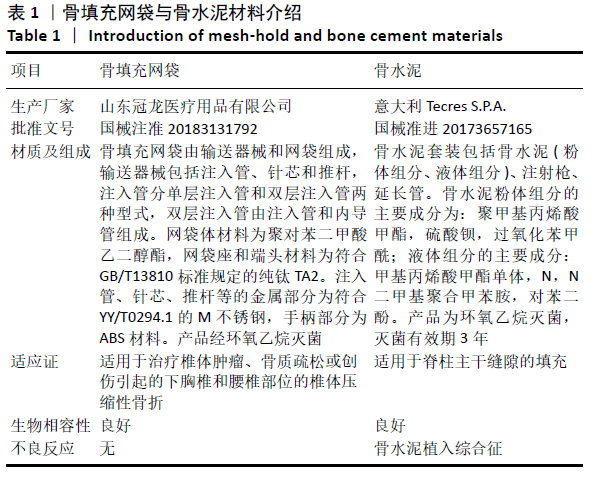中国组织工程研究 ›› 2021, Vol. 25 ›› Issue (34): 5490-5494.doi: 10.12307/2021.244
• 组织工程骨材料Tissue-engineered bone • 上一篇 下一篇
利用骨填充网袋行椎体成形治疗椎体皮质骨破坏的胸腰椎转移癌
李玉伟,王海蛟,崔巍,周鹏,李程、效伟,胡冰涛,李凡
- 漯河市中心医院脊柱外科,河南省漯河市 462000
Percutaneous vertebroplasty with mesh-hold in the treatment of spinal metastases with extensive destruction of cortical bone
Li Yuwei, Wang Haijiao, Cui Wei, Zhou Peng, Li Cheng, Xiao Wei, Hu Bingtao, Li Fan
- Department of Spine, Luohe Central Hospital, Luohe 462000, Henan Province, China
摘要:

文题释义:
骨填充网袋:是一种部分限制骨水泥渗漏的内植物网袋,有一定的防止拔丝期骨水泥远距离渗漏的作用。
椎体成形:一种微创手术,是经皮穿刺后通过向病变椎体内注入骨水泥进而达到强化椎体目的的技术。
胸腰椎转移癌:是一种转移到胸腰椎的恶性肿瘤,常引起局部疼痛、椎体塌陷,最终导致脊髓、神经受压后瘫痪。
背景:经皮椎体成形是一种姑息治疗胸腰椎转移癌的方法,但是对于椎体皮质骨较大范围缺损(≥1/3)者容易出现骨水泥渗漏,所以胸腰椎转移癌椎体皮质骨后缘不完整是椎体成形手术的相对禁忌证。
目的:观察应用骨填充网袋行椎体成形治疗皮质骨破坏胸腰椎转移癌的安全性及疗效。
方法:选择2013年1月至2018年1月漯河市中心医院收治的21例椎体皮质骨破坏的胸腰椎椎体转移癌患者,男10例,女11例,年龄42-87岁,均接受骨填充网袋行椎体成形治疗,术后行局部病椎放射治疗。治疗前及治疗后3 d、6个月时,拍摄X射线片测量病椎前缘高度,利用目测类比评分评估疼痛程度,采用生活自理能力量表评分评估患者生活质量,采用Oswestry功能障碍指数评分评估神经功能变化。研究获漯河市中心医院伦理委员会批准(LH-KY-2013-002-117)。
结果与结论:①21例患者均顺利完成手术,术中见骨水泥注入骨填充网袋过程中,当骨填充网袋逐渐膨胀至一定程度时骨水泥呈线样通过网孔向周围骨松质渗出,进入骨小梁,同时椎体高度一定程度抬升;②术后随访6-21个月,未发生骨水泥渗漏到椎体前方、椎间盘或椎管内,无血管栓塞、肺栓塞及伤口感染等情况;③21例患者术后3 d、6个月的病椎前缘高度均高于术前(P < 0.05),术后3 d、6个月的目测类比评分均低于术前(P < 0.05),术后6个月的生活自理能力量表、Oswestry功能障碍指数评分均低于术前(P < 0.05);④结果表明,对已经失去彻底切除病变机会的胸腰椎转移癌患者,即使存在椎体皮质骨的广泛破坏(占整个椎体皮质骨的1/3以上),仍然可以行骨填充网袋的椎体成形治疗,该治疗的安全性高,能够有效减轻局部疼痛、维持椎体的高度、延迟椎体塌陷与避免骨水泥渗漏。
https://orcid.org/0000-0002-4198-972X (李玉伟)
中图分类号:



